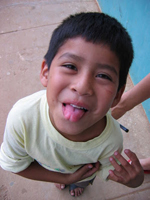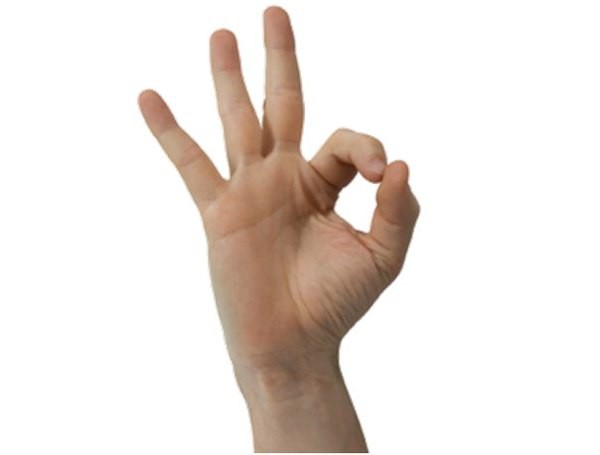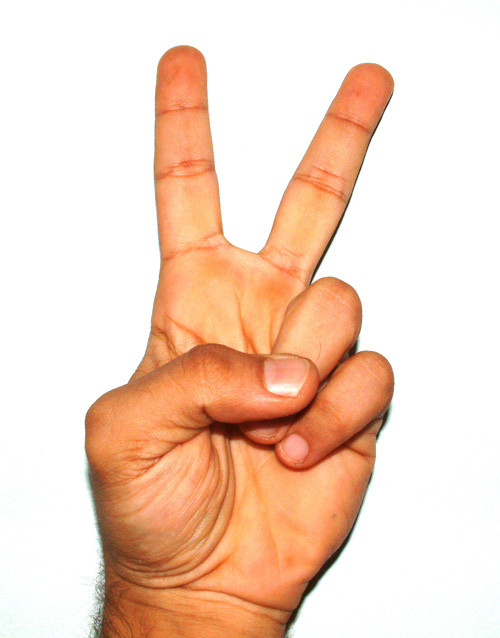How to communicate if you don’t know the language of the country you came to? Well, of course, with gestures! But you need to be careful with sign language, because some “words” in different countries can be translated in different ways.
For example, usually to say “yes” we nod our heads forward, and to say “no” we turn our heads from side to side. But in Bulgaria, it turns out, the opposite is true! Our “yes” in their sign language means “no”, and our “no” means “yes”.
Not confused? Your head is not spinning? Then we go further and learn 9 more gestures.
1. Show language

photo from here
We all know that showing the language is ugly and impolite. But not in Tibet! When you travel through the Tibetan mountains and see that someone is showing you the language, do not rush to be offended - this gesture here means: “I am not plotting against you! Stay calm."
2. Wink

photo from here
We wink with one eye when we want to show our interlocutor that we are joking and that our words do not need to be taken seriously. In France and Australia, this gesture is considered impolite. And in the USA, it is sometimes used simply to say: “everything is in order!”.
3. Lift the thumb up

In most countries of the world this is a sign of approval, with its help we say: “well done!”, “Excellent!”. Hitchhikers usually use this gesture when they catch a car. And in Iran and Australia, this gesture is considered rude and even offensive.
4. Join the thumb and forefinger in the shape of the letter “O ”

photo from here
In the United States, this gesture means “all is well” or “ok.” In Europe (and in Russia too) most often, such a gesture simply means the number “zero”, and in Japan - the word “money”.
5. Twist a finger at the temple

photo from here
We twist our fingers at the temple when we want to say to the interlocutor: “you are crazy!” Or “you say stupidity!”. And in Argentina, Peru, and some African countries, the finger at the temple simply means: “I think.”
6. Raise the middle and index finger in the shape of the letter “V ”
photo from here
In the USA, Great Britain and many other countries, this gesture means the word “victory” (or in English victory). For some reason, people in China and Asian countries are very fond of taking pictures, showing this particular sign. And in Russia and, for example, Bulgaria, the same gesture, but only with the palm pointing toward you, means the number “2”.
7. Touch the nose

photo from here
The Japanese touch their nose when they talk about themselves, i.e. this gesture means the word “I” (and in this case we usually show ourselves on the chest). In Holland, tapping on the nose means: “you are drunk”, and in Syria in general: “get out of here!”
8. Beat yourself on the head

photo from here
To beat yourself on the head is like exclaiming “here I am a fool-a-ak!” Or “How could I not figure it out !?”. The French, Germans and Italians do the same, but the British or Spaniards, on the contrary, praise themselves by patting the head.
9. Fold fingers in an inverted pinch
photo from here
An Italian or a resident of the Caucasus uses this gesture to emphasize the meaning of his words, attract attention, and convince the interlocutor. But if you see this gesture in Israel, it will mean: “Wait a minute, I’ll be right now” (for example, you’ll move your car and you can drive). It is accompanied by an exclamation: "rEG" - the approximate meaning of which is "minute!"
Have you seen interesting gestures somewhere?
If in this country you ate a very tight meal, then out of habit, you should not put your hands with your palms outward, as if refusing and showing that you no longer want to eat. In Greece, a man showing his hand with his palm outward, as if saying that "you enrage me, and I would have dipped you head in ..." This gesture has been going on since the criminals were smeared with black coal or excrement and carried along the streets.
2. The V-shaped finger is offensive in the UK and Australia, although it is popular in these countries. The “V” sign, as a sign of victory, was coined by Winston Churchill. In this meaning, the hand should be turned with the back to the speaker. When the hand is turned with the palm of the person to talk to, the gesture becomes offensive and means “shut up.” Although in most European countries, V - Gesture in any position of the hand means “victory”.
3. “Kukish” in some countries means an offer for sex. Fingers in many countries are associated with sex. In Arab countries, “cookie” means sexual abuse, in Germany this gesture indicates that they want to use the services of a prostitute. In Japan and Thailand, nevermind is perceived as offering a full range of sexual services. In France, this three-finger shape is indecent and means that the middle finger is exposed, but in Portugal and Brazil the fig is a gesture of protection.
4. Other gestures. In Argentina, keeping your hands in your pockets is considered indecent behavior, in Japan it is not recommended to tighten the belt in public - it means the beginning of hara-kiri. Bulgarians, Greeks and Turks, when they say "Yes", shake their heads from side to side, but for us it means "No." Touching a finger for a century, in Italy they express benevolence, in Spain with the help of this gesture they express their doubt about the veracity of what was said, and the Frenchman makes it clear to a person with such a gesture that he is "yap." When an Englishman wants to teach someone a lesson, he raises two fingers together, and in the USA this gesture means a single whole, a team.
5. In European countries, tapping the head with a palm means stupidity. Citizens of France, Germany and Italy knock themselves on the head when they consider some idea silly. If a German hits his forehead with his palm, then it means "You are crazy!" But if in England or Spain a person hits his forehead, then he praises himself for his quick wits. The Dutchman, knocking himself on the forehead, while stretching out his index finger, makes it clear to the interlocutor that he appreciated his mind.
6. Index finger at the temple. Such a gesture is perceived differently in different countries. Scrolling with a finger at a temple in Italy indicates an eccentricity of the person, in Argentina they invite him to the phone with this gesture. In France, a finger at the temple means "stupidity", in Holland it symbolizes "mind", but in Great Britain it is as if this sign says that a person should "live his own mind." In Peru, if a person holds his index finger at his temple, then he is currently thinking.
7. In the countries of the East and Africa should not show the thumb. In West Africa, South America, and the Middle East, don’t show how cool you are with your thumb up. In these countries, this means that you have an indecent intention towards your interlocutor. In a number of countries, such as England, America, Australia and New Zealand, such a gesture has three meanings. It is used when they want to catch a passing car, or making it clear that "everything is fine", and if the thumb is sharply thrown up, then this is insulting and means obscene abuse. In some other countries, such as Greece, such a gesture means “shut up”.
8. Be careful with the OK gesture. In Brazil, for example, this sign, which all over the world means "all is well," is considered obscene. In this country, the “OK” gesture means the same as the middle finger. In Belgium, France, and Latin America, the OK sign is considered offensive and means “insignificance,” and the Greeks show homosexuals like that.
1. Argentina simultaneously occupies three climatic zones.
2. Since 2010, same-sex marriage has been legalized in the country, which is considered a fundamental victory in achieving full equality in modern society.
3. It was in Argentina that an elegant and sensual kind of dance appeared - tango, which managed to find its passionate fans around the world.
4. Football for residents is not just a game, but a national passion.
5. During the most important championships, pupils and students are allowed not to attend classes, if only not to miss such a significant event.
6. Diego Maradona - a symbol and a living icon of the country.
7. Tea drinking using mate tea is considered a true rite. They drink it from one tableware transferred in a circle with the help of a regular tube. To invite a mate for a cup is to demonstrate your sympathy and goodwill.
8. The huge reserves of uranium allow Argentina to conduct serious scientific research related to nuclear energy and the uranium industry.
9. The main food of Argentines is meat. According to its consumption, Argentina takes a stable first place.
10. The Metro, opened in Buenos Aires as early as 1913, was the first in Latin America.
11. Argentines are known not only for their sociability and openness, but also for their optionality and non-punctuality.
12. The real pride of all residents is Argentinean wine, consumed here in large quantities.
13. The streets of Buenos Aires are unsafe. There are constantly taking hostages, robbing banks and shops, stealing cars.
14. Medicine in Argentina is not only free and affordable, but in some respects slightly unusual. For the treatment of intestinal disorders, doctors recommend drinking “7UP” and sprinkle non-healing wounds with sugar.
15. For Argentines, a mandatory element of the toilet room is considered trouble.
16. The streets of Argentina are crowded with numerous beggars and homeless people. Begging is common even for healthy and able-bodied people.
17. The entrances of any home are in excellent condition. Residents monitor their cleanliness and beautiful decoration with flowers, furniture, reproductions and holiday decorations.
19. The main priorities of Argentines include football, meat and sex.
20. Women's beauty in Argentina is symbolized primarily with booty. There are even special contests in the nomination for the best ass.
21. Argentines love their country and are proud of it.
22. In every family there is always an Argentine flag, which is hung on the balconies for any national holiday.
23. In Argentina, it is not customary to yell at children, much less slap them.
24. The family takes an honorable place among Argentines. It is important for them to maintain strong relations even with the most distant relatives.
25. In the event of a divorce, children usually remain with their fathers. Even if the child is with his mother, the father spends with him all the holidays, vacations and weekends.
26. Argentina is famous for its carnivals, held mainly in the month of February.
27. The city of Gualeguaychu has become the venue for the main annual carnival, which is incredibly popular among tourists.
28. Buenos Aires is divided into districts depending on the social status of the multinational population.
29. In Argentina, you will not find people smoking in public places, just like cigarette advertising. It is forbidden to sell cigarettes individually through vending machines and in stores.
30. The Malvinas Islands are considered the main cause of disagreement between Argentina and the United Kingdom. It is on these islands that there is a reserve of oil that British research groups intend to produce, which is completely contrary to the interests of Argentina.
31. Argentinean women are not distinguished by hard work and housekeeping. For them, it is much easier to order food than spend time cooking it. What can we say about the severed buttons that they take to the workshop, so as not to sew on ourselves.
32. In Argentina, there are a huge number of various restaurants.
33. Many Chinese people reliably settled in Argentina, being the owners of many shops, saunas and laundries.
34. Transport connections can only be envied. Cash machines are used for payment. Entrance and exit strictly through special doors. Double-decker buses are used for intercity transfers.
35. Argentinians sympathize with the Russians because of the severe frosts that they have to endure.
36. In the coldest time, Argentines wear only warm gloves and scarves from warm clothes, which does not warm them at all.
37. Girls prefer a simple style, represented mainly by T-shirts and jeans. They don’t use makeup.
38. Ankle boots are usually worn either by prostitutes or transvestites.
39. Numerous hairdressers are needed for dyeing or straightening hair and hair removal. Haircuts in Argentina are a rarity.
40. Among retired grandmothers, it is customary to monitor their style, hair style and manicure.
41. Argentinean men also pay great attention to their appearance and style.
42. On weekends, fairs are always held where you can buy any things (semiprecious stones, clothes, paintings).
43. Empanadas - the most popular dish, which is a pie with all kinds of fillings.
44. The Argentines are recognized as a very patient and polite people, who are unusual to be rude and rude to strangers.
45. School education is very low. One of the main subjects right up to the graduation class is painting.
46. \u200b\u200bMuseums in Argentina can be visited absolutely free or in extremely rare cases for a nominal fee.
47. Love for animals is confirmed by the presence of numerous veterinary clinics, numerous specialized stores and, of course, pets.
48. About 70% of all Argentines do not have their own housing.
49. Taxis are easily recognizable by their black color scheme with a yellow roof. Taxi drivers themselves are very friendly and sociable people.
50. In Argentina, there is no concept of kefir and bread, and the choice of sausage is very small, and even that is tasteless.
51. You can purchase a free newspaper in front of any metro station.
52. Outbreaks of dengue and malaria still occur in Argentina.
53. In the zoo in the city of Luhan, you can not only look at the animals, but also take pictures with predators, entering their cage.
54. Absolutely everyone should take part in the elections.
55. The attitude towards immigrants is excellent. Interethnic conflicts never arise.
56. Among the local Indians, it is customary to celebrate a holiday - race day. On this day, fairs with traditional dances and cuisine are held.
57. In 2001, in just 12 days, four presidents managed to succeed.
58. In the houses it is customary to walk in shoes.
59. The buses have a special retractable step for strollers. It is not uncommon for drivers to provide assistance to people with disabilities.
60. Demonstrations and pickets are quite frequent events, the participants of which block the movement, burn tires and beat drums.
61. Very often you can see men with a gay orientation.
62. Argentines are obsessed with tattoos and piercings.
63. Often, wealthy and middle-income people hire housekeepers and nannies.
64. At meetings and partings, both men and women are usually kissed.
65. An umbrella opened to the premises, according to the Argentines, brings failure. Therefore, this is prohibited.
66. Iguazu Falls in 2011 were recognized as one of the seven wonders of the world.
67. The Argentine city of Ushuaia is the southernmost city on the planet.
68. You can watch dolphins and southern whales in Puerto Madryn, where they sail every year for mating rituals.
69. The fulfillment of 15 years for girls is considered entry into adulthood, and for boys - 18 years.
70. Bariloche - a picturesque city that has collected the most beautiful forests and lakes.
71. Fish themselves are seldom eaten by the coast of Argentina. It is mainly exported.
72. It is in Argentina that important paleontological discoveries were made. This is the land of gigantosaurs, titanosaurs and noasaurs.
73. Los Glaciares is a large ice massif serving as a national park.
74. Argentinean cowboys, gaucho, were constantly persecuted by the government.
75. Caminito street is considered Buenos Aires' calling card, attracting tourists with its brightly painted houses, funny statues, restaurants, retail shops and street musicians.
76. Built in Buenos Aires in 4 weeks, the obelisk is considered the main venue for mass and cultural events.
77. Turning a finger at a temple in Argentina means reflecting on a matter, rather than demonstrating the stupidity of the person you are talking to.
78. Life expectancy is quite high. Argentines live up to 70-80 years.
79. Mount Aconcagua is recognized as the highest in South America.
80. Nowhere in the world do women resort to plastic surgery as often as in Argentina.
81. Pato, a combination of basketball and polo, is a national sport.
82. Only Catholics can apply for the presidency.
83. Argentina ranks first in the world in the number of psychiatrists.
84. Newlyweds should provide a wedding feast without the help of parents.
85. The traditional Argentinean dish on Saturdays is asado - baked meat on the grill.
86. In September, a holiday is held - Sweetness for the Kiss, when a girl should kiss any guy who gave her a cake, candy or chocolate.
87. For Christmas, it is customary to cook sweet bread, sweet slabs of nuts and sweet wine.
88. Argentines most often take vacations in the winter months.
89. The name “Argentina” means “silver” translated from Latin.
90. Argentines are not particularly punctual. For them, half an hour late is considered normal.
91. It is very difficult to get around all the museums in Argentina. Buenos Aires alone has over 110.
92. Argentina boasts the longest street in the whole world, dubbed Prospect July 9th.
93. Calabash is a special dish made from dried pumpkin for the national mate soft drink.
94. Communication between Argentines often comes down to a discussion of two topics: politics and football.
We are used to using various gestures in life, which, as it seems to us, should be interpreted everywhere in the same way. However, this is not entirely true, and you yourself can be unaware of this by talking to foreigners. We decided to eliminate this misunderstanding. Below are the different meanings of the same gestures in different countries.
All over the world means greeting. However, in the East, for example, it is not customary to touch each other without unnecessary necessity and you may be accused of bad manners.
The classical meaning of this phallic gesture is very harsh, and it means a sharp end to the conversation and a wish for a foot erotic journey.
In Thailand and Japan, this gesture will be perceived as a willingness to provide the widest range of sexual services, and in Germany you can get a heavy fine for the middle finger.

A raised thumb is interpreted differently in many countries. If in Germany it is peace-neutral and means the number 1, then in Greece this gesture will be similar to the phrase "Come on!" In Uruguay and Iran, a proudly raised thumb symbolizes an erect male genital organ, and the gesture itself means the threat of sexual violence. The French, showing a thumb, as if they say "Sit on it." If it’s not entirely clear to you what this means, go up a little higher and refresh the interpretation of the thumb in Iran and Uruguay.

Kukish or Dulea
In our country, a cookie is an unproven argument in a protracted dispute. In other words, this is our domestic “fact”, which, however, is not so offensive.
In Japan, China and Korea, figs are perceived as a phallic symbol, and in Germany this gesture can be suggested to have sex. And if in India the three-finger muzzle will be perceived as a threat, then in Turkey and Central America this means a proposal to conduct an express oral sex course.
You can use cookies in Brazil and Portugal for your pleasure, because the local population is used to thinking that such a finger design can bring good luck and drive away evil forces. Ring of the index and thumb - "ok"
In the bulk of cases, it means the absence of problems or “zero”. However, not everywhere.
In France, Portugal, and some Latin American countries, the “OK” gesture that Americans and many Europeans love is perceived as indecent and symbolizes the anus. This is especially acute in Turkey, where a finger ring is an open accusation of homosexuality. But in Tunisia, this gesture can be interpreted as a threat to kill a person.

The oldest sign in the form of a raised up index and middle fingers means triumph and victory. However, in Italy, this palm gesture inward will mean the female genital organ and actions of a corresponding nature.



